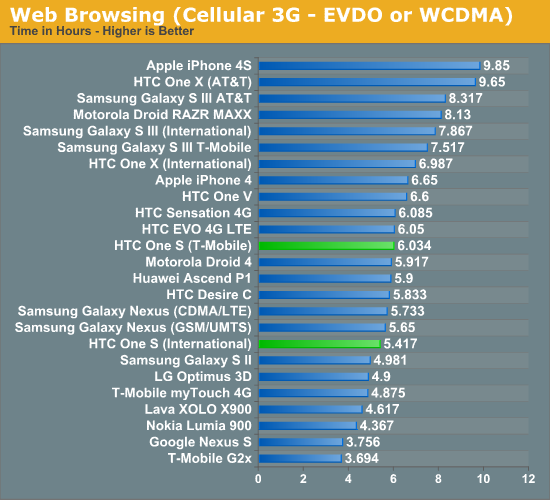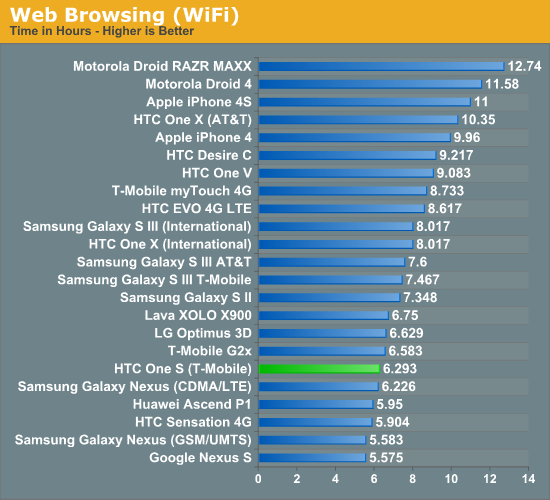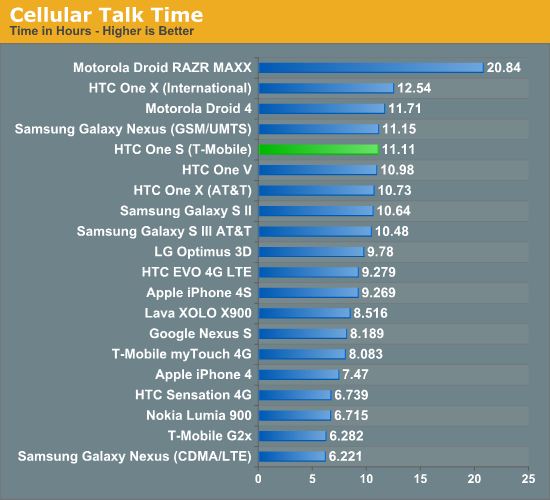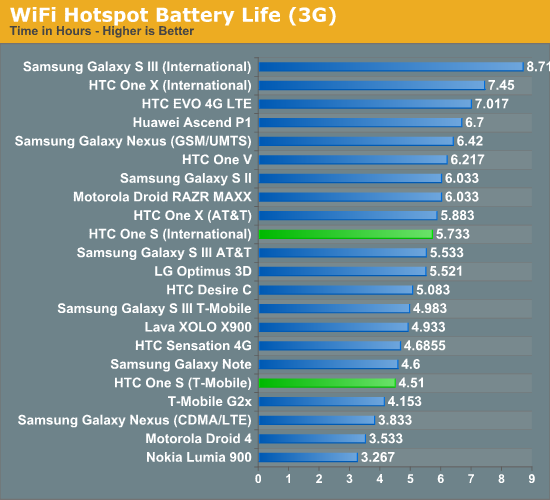HTC One S Review - International and T-Mobile
by Brian Klug on July 17, 2012 9:30 AM ESTThe HTC One S has an internal 1650 mAh 3.7V nominal battery, which works out to a capacity of 6.1 Whr. That’s smaller than the 6.66 Whr battery (1800 mAh, 3.7V) in the HTC One X / XL, but still pretty big for a phone of this size and thickness. The question then becomes what battery life is like on the One S, and to test I turned to our current smartphone battery life tests which I’ve described before. The web browsing tests consist of a few dozen pages which are loaded every 10 seconds with the display set at precisely 200 nits (using a meter) until the phone dies - this is done over WiFi and cellular data. The tethering test consists of a single client notebook attached to the device using its onboard WiFi hotspot function, and four tabs of our page load test alongside a 128 kbps streaming MP3 station are loaded on that notebook until the phone dies.

I should also note that the One S T-Mobile and International results differ somewhat because of the difference in air interface - the T-Mobile variant is on that network’s DC-HSPA+, whereas the One S International I had to test on AT&T in an 850 MHz market (Pinal county) where AT&T holds an 850 MHz license just north of me. Where I live, AT&T is only PCS 1900 MHz.
Remember that DC-HSPA+ is aggregating together two 5 MHz wide WCDMA carriers on the downlink which in theory should require more power from the power amplifiers per unit time. The age old question, however, is whether the increase in throughput can result in the system both achieving a higher data/time rate, and suspending quicker, thus saving some power. Some of the One S International results are also absent because of my limited time in 850 MHz AT&T markets.




I’ve had requests to measure charge time on smartphones, and thankfully the One S makes this possible with the charging status LED. I measured 1.533 hours required to charge the One S from completely empty to full using the supplied charger; this is a pretty speedy charge time compared to some of the other devices I’ve reviewed as of late. I’ll spare everyone the usual rant about USB charging spec and using the right charger that implements the appropriate data pin impedance.
While the One S has basically the same 28nm dual core Krait SoC as the One X (MSM8960 and MSM8260A differ in baseband), the One S also has to deal with a relatively power hungry SAMOLED display. We’ve shown before that this combination suffers in our battery life test especially because our test pages all have white backgrounds.
In day to day use with the One S on auto brightness, I have to say that I’ve never been want for more battery life at all. If you look at the web browsing test, the One S is just a half hour short of the iPhone 4 result. I’d say that’s pretty impressive. If you’re on a One S (or any AMOLED phone) and trying to eek some more longevity out of the device, as always my suggestion is to lower display brightness and set a black background on the home screen, which is what I do with all my AMOLED phones.










97 Comments
View All Comments
michael2k - Tuesday, July 17, 2012 - link
How is the coming on 10 months old iPhone 4S still getting some of the best battery life?What is going on in Android land?
GrizzledYoungMan - Tuesday, July 17, 2012 - link
Faster processors + LTE.Next.
ltcommanderdata - Tuesday, July 17, 2012 - link
I don't think it's that simple. Yes these recent Android phones have newer, faster Krait SoC which could draw more power compared to the Cortex A9 based Apple A5 in the iPhone 4S, however Krait has the advantage of the latest 28nm process to offset this while the A5 is still on the now more than 3 years old Samsung 45nm process. While the CPU portion of newer SoCs is faster than the A5, the A5's GPU is still faster than the GPUs in every other SoC except the recent Exynos 4412. The A5 is also known to be a large die, high transistor design, which won't do it any favours in reducing power consumption. I don't see a faster processor as being a clear disadvantage to battery life in recent Android phones compared to the iPhone 4S.LTE's contribution also probably isn't huge considering these battery tests are specifically done on 3G and WiFi allowing the LTE portion of the baseband to remain idle and power-gate. While hardware choice contributes, I do think software plays a role since Apple can spend all their time optimizing for one specific hardware configuration whereas Android manufacturers don't really have that luxury.
OCedHrt - Tuesday, July 17, 2012 - link
GPU's are power gated when you're not gaming. A powerful GPU doesn't kill battery life unless all you do is gaming.LTE kills battery life whether you use it or not. Just look at those 4 hour LTE phones from last year. The reason is because the LTE radio is a separate chip - it isn't controlled by the SoC and likely cannot be power gated.
The current generation of 28 nm w/ LTE on chip does have much better battery life - however with Android's multitasking, background syncing, Android simply isn't going to get longer battery life than iPhone 4s unless you turn it all off - and you can turn it off.
Then, as many iPhone 4s users will tell you, many of them also get shitty battery life - it probably depends even more so on how you use it.
amdwilliam1985 - Tuesday, July 17, 2012 - link
"Then, as many iPhone 4s users will tell you, many of them also get shitty battery life - it probably depends even more so on how you use it."Totally agreed, a coworker here with iPhone 4 has battery drained from ~85% to ~55% overnight in "standby" mode.
My SGS2 can go through 2 normal days easily now that I enabled wifi calling and using edge(~10k/s, it's more than enough for texting and syncing).
OCedHrt - Tuesday, July 17, 2012 - link
My One S's wifi calling drains more battery than 3G with strong signal.leexgx - Wednesday, July 18, 2012 - link
what stands out is how can the Motorola Droid RAZR Maxx have such poor web 3G browsing (unless the USA version test was done with LTE then i would cida under stand then) and Wifi Hotspot Battery timethat seems impossible with the 3200mha bat at its disposal i cant see how them results are correct for that phone
what also surprises me is How you manage to get most of these phones to last more then 4-5hrs of constant use (that lacks an secondary Clip on battery like i just got for my HTC One X or an bigger battery like i had for my HTC Desire phone) any phone i see cant seem to last the day of Light use half an day if used in the day unless power is supplied in the day
one thing i hate about the HTC one X an little is Power button really could do with been on the side like the Samsung S3 (phone is to long for 1 hand power button at the top) not sure if its me but phone seems to have been made for Left handed users, the answer and hangup icons have been switched (answer should be on the left and hang up should be on the right) sure that's how my HTC desire had it (guess i should turn on on before i look dumb :) )
other thing as well WiFi and Data go into Forced power saving mode after midnight to about 8am (it turns Wifi off and data Off Even if its Plugged into power after 15 mins screen off, comes back on screen comes on)
OCedHrt - Wednesday, July 18, 2012 - link
I easily get 5+ hours of constant use on my One S. The screen uses up most of the battery, and the on time is always over 5 hours. Sometimes more than 6.name99 - Tuesday, July 17, 2012 - link
Was the coworker using Skype?Skype is notorious for draining the battery rapidly, even while in the background. It's one of the few apps that CAN do so because it's a VoIP app so gets background time (and it basically proves Apple's point that if you allow background apps time, they WILL be written by crappy engineers and they WILL do a crappy job.)
Without wanting to make a big deal about it, I'd point out that under normal circumstances (ie Skype NOT running in the background) my iPhone4 drains by around 5% or less overnight. With Skype running it will drain by 30% or so --- which basically matches what your co-worker was seeing.
OCedHrt - Wednesday, July 18, 2012 - link
Skype is pretty crappy, but there are other, better, VoIP apps available on Android.